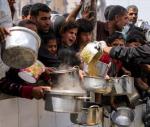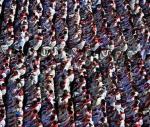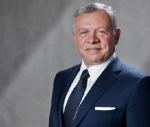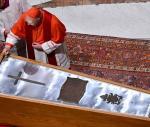You are here
Kurdish forces start Syria-Turkey border pullback
By AFP - Oct 24,2019 - Last updated at Oct 24,2019
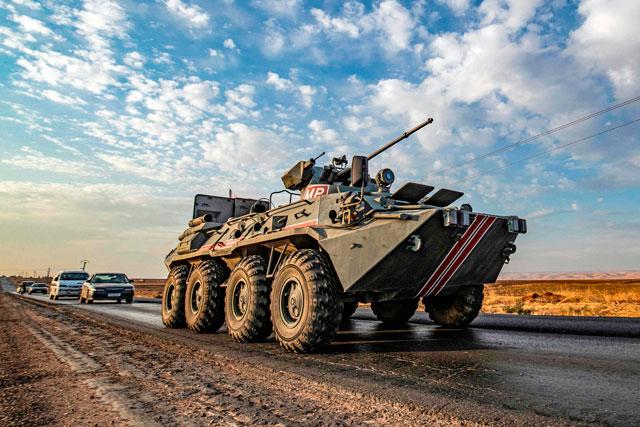
A Russian military police armoured vehicle drives along a road in the countryside near the north-eastern Syrian town of Amuda in Hasakeh province on Thursday, as part of a joint patrol between Russian forces and Syrian Kurdish Asayesh internal security forces near the border with Turkey (AFP photo)
QAMISHLI, Syria — Kurdish forces in north-eastern Syria left several positions along the long border with Turkey on Thursday, complying with a deal that sees Damascus, Ankara and Moscow carve up their now-defunct autonomous region.
Russian forces have started patrols along the flashpoint frontier, filling the vacuum left by a US troop withdrawal.
An AFP correspondent saw a Russian patrol set off from the town of Qamishli westwards along the Turkish border flying Russian flags, accompanied by Kurdish security forces.
US President Donald Trump has praised the agreement reached in Sochi by NATO member Turkey and Russia and rejoiced that US personnel were leaving the "long blood-stained sand" of Syria, leaving just a residual contingent behind "where they have the oil".
The deal signed in the Black Sea resort by Syria's two main foreign brokers gives Kurdish forces until Tuesday to withdraw to a line 30 kilometres from the border.
The Syrian Observatory for Human Rights reported that the Kurdish-led Syrian Democratic Forces had pulled out of some areas at the eastern end of the border on Thursday.
“The SDF have withdrawn from positions between Derbasiyeh and Amuda in the Hasakeh countryside,” the Britain-based war monitor’s head, Rami Abdel Rahman, said.
Fighters of the Kurdish People’s Protection Units (YPG) — the main component of the SDF — remained in many positions along the 440 kilometre, he added.
The observatory also reported clashes near the town of Tal Tamr between SDF fighters and some of the Syrian former rebels paid by Turkey to fight ground battles.
SDF commander Mazloum Abdi on Twitter accused the Turkish-led forces of violating the truce on the eastern front of Ras Al Ain.
“The guarantors of the ceasefire must carry out their responsibilities to rein in the Turks,” he added on Twitter.
The events were set to provoke “forceful” discussion at a NATO defence minister meeting in Brussels on Thursday and Friday but Ankara risked little because of its strategic position, diplomats said.
Russian and Syrian government forces were deploying across the Kurdish heartland to assist “the removal of YPG elements and their weapons”.
Kurdish forces had already vacated a 120-kilometre segment of the border strip — an Arab-majority area between the towns of Ras Al Ain and Tall Abyad.
The SDF withdrawal from that area came after Turkey and its Syrian proxies launched their deadly cross-border offensive on October 9.
Turkish President Recep Tayyip Erdogan hopes to use the pocket to resettle at least half of the 3.6 million Syrian refugees his country hosts.
Under the Sochi deal, the area will remain under the full control of Turkey, unlike the rest of the projected buffer zone which will eventually be jointly patrolled by Turkey and Russia.
Some 300,000 people have fled their homes since the start of the Turkish offensive and many Kurds among them seem unlikely to return.
Oil wells
US forces pulled back from the border area earlier this month, in a move the Kurds saw as a betrayal but which Trump had discussed since last year.
The autonomous Kurdish administration in Syria had hoped that the sacrifices made in the name of the international community to help crush the Daesh terror group’s “caliphate” would pay off.
But Trump has been keen to keep a promise to remove his troops from Syria, where Daesh’s “caliphate” was eliminated in March but where conflict continues.
“Let someone else fight over this long blood-stained sand,” he said in a White House speech on Wednesday.
Some US forces remain in eastern districts of Syria, where government forces have been deploying but have not yet re-established full control.
“We have secured the oil and, therefore, a small number of US troops will remain in the area where they have the oil,” Trump said on Wednesday.
The Syrian government is keen to reclaim the northeast, which is home to the country’s main oilfields and some of its most fertile farmland.
Related Articles
BEIRUT — Alarmed by a US decision to leave Syria, Kurdish leaders who run much of the north are urging Russia and its ally Damascus to send
TALL ABYAD, Syria — A car bomb killed at least 13 people in a Turkish-held border town in northeast Syria Saturday, as thousands of Kurds in
BRUSSELS — Turkey’s military operation in Syria was expected to spark “forceful” discussion at a NATO defence ministers’ meeting on Thursday










